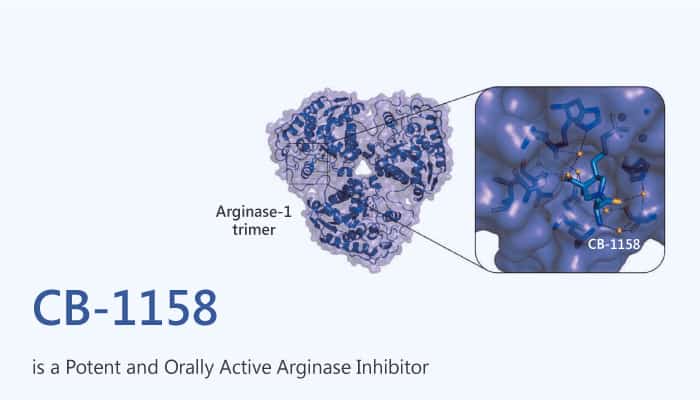Myeloid cells are an abundant leukocyte in many types of tumors and contribute to immune evasion. The major populations of tumor-infiltrating myeloid cells include tumor-associated macrophages (TAMs), myeloid-derived suppressor cells (MDSCs), and granulocytes. A feature common to all of these immunosuppressive cells is their expression of the enzyme arginase 1 (Arg1). Arg1 catalyzes the hydrolysis of the amino acid L-arginine to produce urea and L-ornithine, thereby depleting extracellular L-arginine. Meanwhile, T cells are auxotrophic for L-arginine, requiring the amino acid for the rapid and successive rounds of proliferation that follow T cell antigen receptor (TCR)-dependent activation of effector cells. Blocking Arg1 activity in the context of cancer could therefore shift the balance of L-arginine metabolism to favor lymphocyte proliferation. In this study, CB-1158 is a potent and orally-bioavailable small-molecule inhibitor of Arg1. The IC50s of 86 and 296 nM for recombinant human arginase 1 and 2, respectively.

CB-1158, a potent and orally bioavailable inhibitor of arginase, blocks myeloid cell-mediated immune suppression in the tumor microenvironment.
CB-1158 inhibits native arginase 1 (Arg1) in human granulocyte, erythrocyte, and hepatocyte lysate with IC50s of 178 nM, 116 nM, and 158 nM, respectively, and blocks Arg1 in cancer patient plasma (IC50, 122 nM). Moreover, CB-1158 also exhibits potent inhibitory activity against arginase in human HepG2, K562 cell lines, and primary human hepatocytes with IC50s of 32, 139, 210 μM, respectively. CB-1158 shows no effect on NOS. Furthermore, CB-1158 is not directly cytotoxic to murine cancer cell lines. CB-1158 also increases the number of tumor-infiltrating cytotoxic cells and decreases myeloid cells in mice. In addition, CB-1158 in combination with PD-L1 blockade or gemcitabine inhibits tumor growth in mice bearing CT26 cancer cells.
In summary, CB-1158 blocked myeloid cell-mediated suppression of T cell proliferation in vitro and reduced tumor growth in multiple mouse models of cancer, as a single agent and in combination with checkpoint blockade, adoptive T cell therapy, adoptive NK cell therapy, and the chemotherapy agent gemcitabine.
Reference:
Steggerda SM, et al. J Immunother Cancer. 2017 Dec 19;5(1):101.